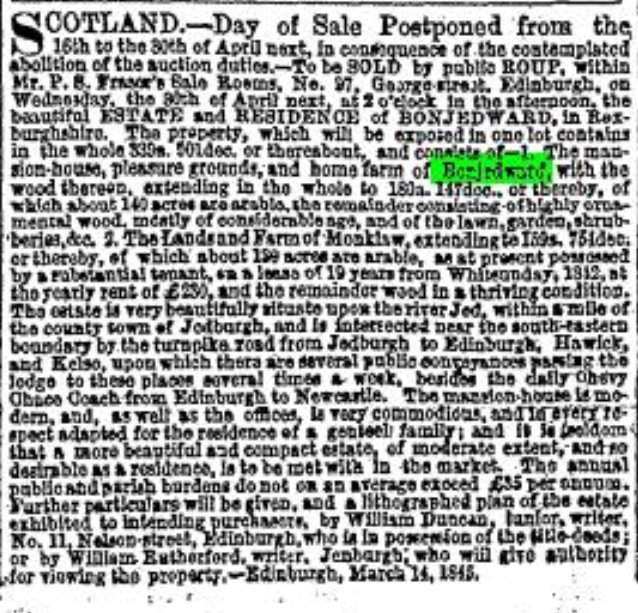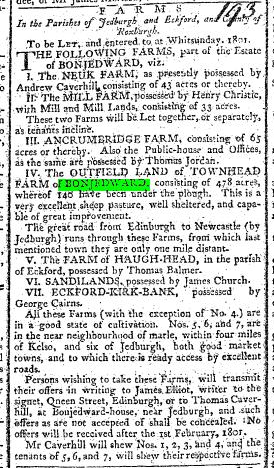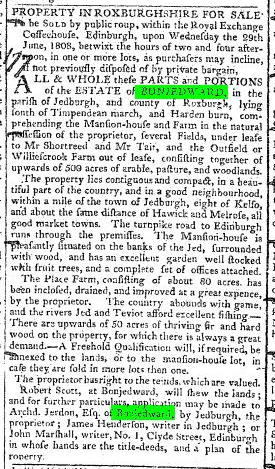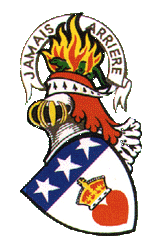Bonjedward
This page is a stub
Sally Douglas has
contributed an article on the Lands of Bonjedward and the Douglas
inheritance. It is available as a
flipbook, and as a pdf:

Bonjedward stands on a ridge of land formed by the approach of
the Teviot and Jed towards their junction. There are a wide variety
of spellings: Bonne Jedburgh, Bon Jedburgh, Bonjedward, Bonjedworth,
Beanjeddart, Bonjedwart, Boniedworth, Bonjedburght, Bunjedworth,
Bondeidde ford, Boniedworth, Bonjeddeworth, and
many more. Bon is taken from
bun, which is commonly used in the sense of 'river-mouth'. It
appears the River Jed may have been known as Jedward.
The
castle and town of Bonjedworth suffered their full share of the
miseries of border warfare. The castle was converted at a later
period into a gaol. In 1683 Sir John Biddell of that ilk and another
were tried at the court of justiciary at Jedburgh for their
religious opinions, and sentenced to be confined in the prison of
Bonjedworth. The castle is now so completely demolished that not a
trace of even its situation can be found. It was, in 1850, an
inconsiderable hamlet though once a seat of strength having
possessed a castle of some note.
A short distance farther to
the west of the likely castle site is Bonjedward House, a
magnificent listed Georgian house dating from the latter stages of
the 18th century. It was remodelled and extended during the next
century and is set in an imposing position in the centre of its own
extensive gardens and policies. The house is built of cream
sandstone rubble with polished cream ashlar dressings.
Bonjedward was, as part of large holdings in the Jedburgh Forest,
and elsewhere, in 1320 granted by King Robert Bruce to 'The Good'
Sir James Douglas, partly as a reward for his support at the battle
of Bannockburn, and partly to bind him to the Bruce cause. These
estates passed to James, 2nd earl of Douglas. Douglas married the
Princess Isabel, a daughter of King Robert II of Scotland. He left
no legitimate male issue. His natural sons William and Archibald
became the ancestors of the families of Douglas of Drumlanrig (see
Marquess of Queensberry) and Douglas of Cavers. His sister Isabel,
inherited the lands and earldom of Mar, and the unentailed estates
of Douglas. Isabel arranged for the Bonjedward estate, then
including nearby Timpendean, to be passed to their half-sister,
Margaret, who became 1st Laird of Bonjedward. Margaret had married a
Thomas Johnson, but he and his son, John, changed their names to
Douglas.
In 1479, George Douglas of Bonjedward, with consent
of his heir, James, granted Timpendean to a younger son, Andrew.
James appears to have died before his father, so in 1540 William
Douglas, then son and heir of the late George Douglas of Bonjedward
became Laird of Bonjedward.
In about 1710, Thomas Rutherfurd
of Edgerston acquired the lands of Bonjedward and Mounthooly ,
together with the estates of Hunthill and Scraesburgh. In 1845,
Bonjedward was sold to the Marquess of Lothian, in whose ownership
much of the estate continues, the estate offices being located in
the stables for Jedneuk House, which were converted to form a suite
of offices.
Bonjedward, 'Jedward-foot ' from bun, which is common in the sense
of 'river-mouth,' as in Bun Abha, Bonawe, 'Awe-foot.' It seems that
the Gaelic people took Jedward to be the name of the river, instead
of Jed, plainly a case of Gaelic supervening on English.
“Beanjeddart,
Hundlie, and Huntil...” Douglas of Beanjeddart, an ancient branch of
the house of Cavers, possessed property near the junction of the Jed
and the Tiviot. (Beanjeddart = Bon Jedburgh.)
The castle and town of Bonjedworth suffered their full share of the
miseries of border warfare. The castle was converted at a later
period into a gaol. In 1683 Sir John Biddell of that ilk and another
were tried at the court of justiciary at Jedburgh for their
religious opinions, and sentenced to be confined in the prison of
Bonjedworth. There is now no vestige of this important fort. Two
farm onsteads and a few scattered cottages occupy the site of this
ancient town.
Extract from
Rutherfurd's border hand-book of 1849
The village of
BONJEDWARD stands on a ridge of land formed by the approach of the
Teviot and Jed towards their junction It is now an inconsiderable
hamlet though once a seat of strength having possessed a castle of
some note During the latter part of the 17th century a number of
persons concerned in the rising of the Covenanters were imprisoned
in it but the castle is now so completely demolished that not a
trace of even its situation can be found A short distance farther to
the west is Bonjedward House the seat of the Honourable Mr Talbot
The view of Jedburgh on entering from the west has often been the
theme of admiration to the traveller but that from the east is also
of a very pleasing character Turning the curve of the road beyond
Bonjedward wood the smoke of the old burgh comes on the view while
the old abbey towers above the roofs a mass of sombre ruin giving
the scene in connection with the uplands which surround it a highly
picturesque appearance.
 Bonjedward
House is a magnificent listed Georgian house dating from the latter
stages of the 18th century. Built for Archibald Jerdon of Bonjedward
and later the seat of the Dowager Marchioness of Lothian.
Bonjedward House is a substantial Georgian country home. It was
remodelled and extended during the next century and is set in an
imposing position in the centre of its own extensive gardens and
policies.
Bonjedward
House is a magnificent listed Georgian house dating from the latter
stages of the 18th century. Built for Archibald Jerdon of Bonjedward
and later the seat of the Dowager Marchioness of Lothian.
Bonjedward House is a substantial Georgian country home. It was
remodelled and extended during the next century and is set in an
imposing position in the centre of its own extensive gardens and
policies.
Bonjedward House requires (in 2020) internal completion, offering
extensive and versatile accommodation and set at the end of a long
tree-lined drive ending in a large gravel sweep parking area. The
house has been partially rewired and had a new plumbing and central
heating system installed. Originally dating from the early
nineteenth century, the house is constructed of sandstone rubble
with cream margins, moulded eaves and piended roof, and boasts a
wealth of period features including ornate cornicing and
Neoclassical plasterwork, original fireplaces, and sash and case
windows with working shutters.
Thomas Rutherfurd of Edgerston succeeded his brother Andrew, in
1718. During his lifetime he acquired the lands of Bonjedward and
Mounthooly, together with the estates of Hunthill and Scraesburgh.
He is designed as Thomas Rutherfurd of Wells, in 1703. He married
Susanna, daughter and heiress of Walter Riddell of Mynto. Susanna
Riddell, Lady Rutherfurd, is mentioned as a widow in an agreement
with her son, Sir John, regarding her provision, dated at Jedburgh,
13th February, 1722. It may be assumed, therefore, that Thomas
Rutherfurd died about 1720.
THOMAS CALDERWOOD OF POLTON
inherited considerable wealth from his father and in March 1735
married Margaret eldest daughter of Sir James Steuart of Goodtrees
Baronet Solicitor General for Scotland by Anna daughter of Sir Hew
Dalrymple of Northberwick President of the Court of Session who was
then in her twentieth year. Mr and Mrs Calderwood returned to London
in the spring of 1757 (from the Low countries) and in the following
year Mr Calderwood devolved upon his wife the entire management of
his estates and family affairs. Mrs Calderwood with her husband's
consent sold his property of Bonjedward in Tweeddale and applied the
price to the purchase of Linhouse. That this acquisition did not
realise the full benefit which she anticipated was in part owing to
the backward nature of its soil but she was thus enabled to hand
over to her elder son six thousand acres of land in Mid Lothian on
his coming of age and receiving from his father the family estate.
On 17 Sep 1809, Mr James Tait married Susan, 5th daughter
of Thomas Caverhill at or of Bonjedward. (See below)
In the year, 1847,
Major Forbes, who was then a tenant of the Marquis of Lothian,
having taken Bonjedward House for a residence, became a member of
the Jedforest Club. There is no further information about this
gentleman.
In 1849, Bonjedward House was the seat of the
Honourable Mr Talbot
It appears to have been owned by Major
Pringle in 1856.
On 19th Feb 1867, the infant son of
Vice-Admiral the Hon Charles Elliot died at Bonjedward.
William Penney, The Hon. Lord Kinloch, Judge of the Court of
Session, Scotland, was living in the house in 1870.
Thomas
Caverhill Jerdon, zoologist, (12 October 1811 - 12 June 1872) was
the eldest son of Archibald Jerdon of Bonjedward
...ARCHIBALD JERDON, of Allerton. was elected a Fellow of the
Society in 1871. He was born at Bonjedward on 21st September 1819,
and educated at the Edinburgh ...
...Its history, as now
confirmed, traces the painting to the ownership of Peter
Alexander Speirs, of Bonjedward House, Jedburgh, Scotland, a nephew
of the ...
Richard Swan may have been the owner in 1979,
when he married Jean Agnew.
Archibald Jerdon of Bonjedward
was the only son of Thomas Caverhill and Jane Jerdon, only daughter
of Archibald Jerdon of Bonjedward, nicknamed " Baldy." The subject
of this memoir was baptized Archibald Jerdon, as heir to his
grandfather, the laird of Bonjedward. There was also one daughter of
the marriage, Jane Caverhill, who married the Rev. Peter Young of
Jedburgh. As a marriage portion Mr Jerdon gave his daughter the farm
of Bonjedward Townhead, and built a suitable house for her as a
residence. She died there on the 29th of February 1780, aged 30
years.
Thomas Caverhill was the nephew of Andrew Caverhill
of Jedburgh. He married, secondly, Jane Douglas, and by her had
several daughters; she died in 1797, aged 38 years.
Archibald Jerdon was educated at the Grammar School, Durham, and
there became acquainted with Mr Milner of South Shields, whose
sister, Elizabeth Sarah Milner, he afterwards married. When the old
laird of Bonjedward died, Archibald was still in his minority. A
family of the name of Jerdon claimed the estate — they were
relations of the Jerdons who then lived at The Nest, Jedburgh. A
lawsuit followed. Archibald's agent was Cgmelius Elliot of WooUee,
(?Woodlee) W.S., who got the case decided in his client's favour. After Mr Jerdon married, he resided at Bonjedward House. His family consisted
of two sons and five daughters.
From its formation he was a
member of the Jedforest Club.
In the year 1810 he was
appointed captain in the 1st Regiment of Roxburghshire local
militia. This was not his first taste of soldiering, however, for he
had formerly held a commission in the Jedburgh volunteers. Mr Jerdon
was very popular in and around Jedburgh. He was an extremely
kind-hearted man, and most liberal in all his dealings — perhaps too
much so for his income. More than once he got himself into
difficulties, and was obliged to sell portions of his Bonjedward
estate. In the year 1842, Mr and Mrs Jerdon died, within a short
time of each other, through eating something poisonous, it was
generally believed. Many stories were current at the time, but,
curious to relate, no steps were taken to discover what the poison
consisted of, or how it came to be administered. Another of the
family, Mrs Jerdon's sister, also died suddenly, not very long
afterwards, in an equally mysterious manner. Husband and wife were
buried on the same day in the Abbey churchyard.
In 1845,
Bonjedward was sold to the Marquess of Lothian, who now (1899)
possesses the whole estate.
Mrs Maxine Anne Day (or Willson) acquired the house in December
1999, shortly after the death of her first husband, the late Peter
Day, at a price of £465,000; it had been valued by her surveyor at
£430,000. The property comprised Bonjedward House itself, which she
made her home, and certain cottages and outbuildings. She later
married Andrew Willson, and lived in Bonjedward. They divorced in
2008.
 The
London Times, Sat 22 March, 1845
The
London Times, Sat 22 March, 1845
 |
 |
| Caledonian Mercury – 13/9/1800 |
Caledonian Mercury 9/6/1808 |
Particular Register of Sasines Minutes
Book (Roxburgh, Selkirk and Peebles)
Sasines of 3 July,1773
·
24 March,1780 –
Roxburghshire – Archibald Jordon (Jardine/Jerdon) of parts of he
lands of Bonjedburgh or Bonjedward viz. the west part or Westend of
Bonjedward mains, Bellshaugh Garden at Bonjedward, and two
enclosures and grass between the plantations at Bonjedward House,
Ancrum Bridge End Farm, Williescrook Park, Mains Sheeprigs, and
houses and yards of Bonjedward, Parish of Jedburgh, Roxburghshire,
on a charter under the Great Seal in favour of Archibald Douglas of
Douglas(1) dated 3 July,
1773, and a disposition by him to the said Archibald Jordan.
·
24 March,1780 –
Roxburghshire – Hay Donaldson writer
in Haddington of parts of the lands of Bonjedward or Bonjedburgh
viz. the Horsepark at Place, Sunnybraes Park, Triangle, Greenleaves
Park, Douglas Park and planting arable to the west of the turnpike
road and Sharplaw, remainder of Ancrum Bridge Farm above the road,
Shoottrades and Boomlands Parks, Williesland Park, Monklaw Park and
planting, Williescrook Park and muir pasture, and planting on four
plots south of Hardenburn, and of some houses and yards in
Bonjedward, Parish of Jedburgh, Roxburghshire, on a charter under
the Great Seal in favour of Archibald Douglas of Douglas dated 3
July, 1773 and a disposition and assignation by him to the said Hay
Donaldson.
·
24 March,1780 –
Roxburghshire – Henry Hall tenant in Linthaughlee of parts of the
lands of Bonjedward or Bonjedburgh viz. the Eastpart or Eastend of
Bonjedward Mains, Bawhaugh, Bankend Park and Waulkmiln and lands
possessed with the same, Burn Park and some houses and yards in
Bonjedward, Parish of Jedburgh, Roxburghshire, on a charter under
the Great Seal in favour of Archibald Douglas of Douglas dated 3
July, 1773 and a disposition and assignation by him to the said
Henry Hall.
·
24 March,1780 –
Roxburghshire – Charles Rankine chirurgeon in Douglas of parts of
the lands of Bonjedward or Bonjedburgh viz. the farm of Bonjedward,
the Milllands, Mill and multures of Bonjedward with the haugh above
the water and two parks on the east of the lower yard of Bonjedward,
a clover park on the north and two other parks on the south side of
the village of Bonjedward, the lower yard of Bonjedward with two
parks at the foot of the Middle Muir with arable lands lying above
the said yard and park at Williescrook, and some houses and yards in
Bonjedward, Parish of Jedburgh, Roxburghshire, on a charter under
the Great Seal in favour of Archibald Douglas of Douglas dated 3
July 1773 and a disposition and assignation by him to the said
Charles Rankine.
·
24 March,1780 –
Roxburghshire – Thomas Maitland Esq late of Loutrie of parts of the
lands of Bonjedward or Bonjedburgh viz. Ashiebank, Craigs Park,
Simples Yatt, West Craig Inclosure, Calf Park and Easter Stonnybraes,
Tuupark at Bonjedward Town, three houses and yards at Bonjedward,
Night Park, Whitelawhaugh Park, Upper Whitelaw Park, Wellpark,
Huntknow Park, Calderwood’s Plantation and the grass grounds on the
west thereof, Longpark and farm acres, and some houses and yards in
Bonjedward and the Birney Common, with houses, biggings, yards,
multures and tiends parsonage and vicarage if the said lands, Parish
of Jedburgh, Roxburghshire, on a charter under
the Great Seal in favour of Archibald Douglas of Douglas dated 3
July 1773 and a disposition and assignation by him to the said
Thomas Maitland.
·
24 March,1780 –
Roxburghshire – Alexander Mckonochie writer in Edinburgh of parts of
the lands of Bonjedward or Bonjedburgh viz. the pasture ground to
the westward of Huntknow Parh, Town Sheeprigs, Wester and Easter
Meadow, Short and Long Sheeprigs, Easter Bank Park, Wester Bank
Park, Backcrop Park, Barn Park, Townhouse Park, Town Cow Park at the
Place, Wester Stonnybraes, Calf Park, and Planting Coastly or
Crossly Park, and some houses and yards in Bonjedward, and the
houses, biggings, yards, multures and teinds parsonage and vicarage
of the said lands, Parish of Jedburgh, Roxburghshire, on a charter
under the Great Seal in favour of Archibald Douglas of Douglas dated
3 July 1773 and a disposition and assignation by him to the said
Alexander Mckonochie.
I
am indebted to Sally Douglas who has compiled a history of the Douglases
of Bonjedward and Timpendean.
This can be downloaded as a pdf
 or as a
Flip Book..
or as a
Flip Book..
Note:
1
.
Archibald Douglas of
Douglas is probably the nephew of the Duke of Douglas, whose
lands he inherited, giving rise to the Douglas Cause court case.
See also:
a.
Douglas of Bonjedward
b.
Map of the area, 1654
Extracted from Blaeu Atlas of Scotland, 1654. Opens in a new window
c.
Peles, towers and bastles of the Scottish Borders (pdf)
Any contributions will be
gratefully accepted
Errors and Omissions
|
|
The Forum
|
|
What's new?
|
|
We are looking for your help to improve the accuracy of The Douglas
Archives.
If you spot errors, or omissions, then
please do let us know
Contributions
Many articles are stubs which would benefit from re-writing.
Can you help?
Copyright
You are not authorized to add this page or any images from this page
to Ancestry.com (or its subsidiaries) or other fee-paying sites
without our express permission and then, if given, only by including
our copyright and a URL link to the web site.
|
|
If you have met a brick wall
with your research, then posting a notice in the Douglas Archives
Forum may be the answer. Or, it may help you find the answer!
You may also be able to help others answer their queries.
Visit the
Douglas Archives Forum.
2 Minute Survey
To provide feedback on the website, please take a couple of
minutes to complete our
survey.
|
|
We try to keep everyone up to date with new entries, via our
What's New section on the
home page.
We also use
the Community
Network to keep researchers abreast of developments in the
Douglas Archives.
Help with costs
Maintaining the three sections of the site has its costs. Any
contribution the defray them is very welcome
Donate
Newsletter
Our newsletter service has been temporarily withdrawn.
|
|
|
|
|
|
|
|


